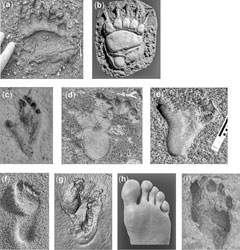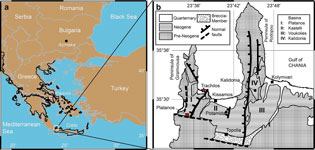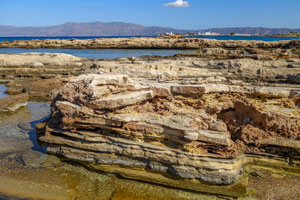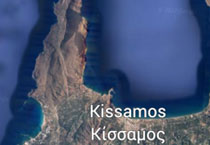|
Home
Page 1/5
Page 2/5
Page 3/5 (this page)
Page 4/5
Page 5/5
|
Looking for the northern ape-man webpage 3/5
Text, photography: Annemieke van Roekel
Ape-foot with human toes
The article from 2017 states that there are
42 oval impressions in sandstone, and that two separate tracks can be recognized
in the SSW-NNE direction. "Scientifically, it's an important site," says Ahlberg,
who visited the site several times. "To me it's very convincing that these are prints
of a pre-human species, because the foot shape is so distinctive and unique. The Trachilos prints
(Fig. 6g) are clearly recognizable as 'human', for everyone. In fact, it is only paleoanthropologists
who ever question this. The Trachilos tracks are interesting to me for various reasons: because they are
so old, they have not been found in Africa, the morphology indicates early human and because they are a
fossilized film-clip of an animal that is alive. In addition, foot bones are rare in the fossil record
because they are easily lost and quickly eaten by scavengers."
 Fig. 9. Comparison of different footprints: (a) brown bear manus print; (b) Grizzly bear manus;
(c) pes vervet monkey; (d) pes and knuckle prints lowland gorilla; (e) chimpanzee pes print;
(f) human foot print; (g) Trachilos print; (h) human foot; (i) footprint of an early Homo erectus
in Ileret, Lake Turkana, Kenya. Bron: Gierlinski et al., 2017.
Fig. 9. Comparison of different footprints: (a) brown bear manus print; (b) Grizzly bear manus;
(c) pes vervet monkey; (d) pes and knuckle prints lowland gorilla; (e) chimpanzee pes print;
(f) human foot print; (g) Trachilos print; (h) human foot; (i) footprint of an early Homo erectus
in Ileret, Lake Turkana, Kenya. Bron: Gierlinski et al., 2017.
Ahlberg: "Striking about the prints is that the heel is flat on the ground. We humans, unlike most
other animals, walk on our whole foot, which is quite unusual. Typical of a human foot is that the big toe
is actually much larger than the other toes. But what make these tracks particularly human is that the big
toe is placed right next to the other toes, and not sticking out like in the foot of a chimpanzee or gorilla.
In contrast, compared to a modern human's foot, the Trachilos foot is much shorter and wider. Our heel is a kind
of bulb, and we have a foot arch, so the middle part of a human footprint is narrow. It would be reasonable to describe
the Trachilos foot as an ape-foot with human toes."
The prints come from a small creature, no taller than 1 meter and with feet between 12 and 21 cm, similar to the feet
of a seven-year-old human child. "In terms of tracks, I find the Trachilos prints very challenging," Ahlberg says.
There are several individuals of different sizes. What we do not see anywhere is prints
of hands or knuckles resting on the ground. What is also striking is that the track is very narrow,
which indicates that one foot is put in front of the other. A chimpanzee or gorilla would make a wide
track. Such a narrow track says a lot about the shape of the skeleton."
 Fig. 10. Left: Study area NW Crete. Black line: current coastline; brown: land around 6 Ma; NW Crete
was connected to the mainland and consisted of about four islands.
Right: Local geology of the study area. Red star: Trachilos site. Kirscher et al., 2021.
Fig. 10. Left: Study area NW Crete. Black line: current coastline; brown: land around 6 Ma; NW Crete
was connected to the mainland and consisted of about four islands.
Right: Local geology of the study area. Red star: Trachilos site. Kirscher et al., 2021.
New dating
Based on foraminifera (single-celled organisms with an external calcareous skeleton) the layers were
initially dated to be at least 5.7 million years old (Gierlinski et al., 2017). The footprint horizon
is stratigraphically part of the Platanos Basin: a succession of shallow marine sediments (carbonates
and siliciclastics) (Gierlinski et al., 2017). This sequence ends with coarse-grained continental sediments,
initially associated with the Messinian Salinity Crisis (MSC) around 5.5 million years ago, when the Mediterranean
Sea largely dried up. The researchers interpret the sediments in Trachilos as a sandy plain in the vicinity of the
sea, and possibly part of a river delta. Fig. 10 and 11.
 Fig. 11. Sedimentary sequence of the sandstone layer with prints is followed seaward.
The trackway horizon is approximately above the fractured layer.
In the background the harbor of Kissamos and behind it the Rodopos Peninsula. Photo: A. van Roekel.
Fig. 11. Sedimentary sequence of the sandstone layer with prints is followed seaward.
The trackway horizon is approximately above the fractured layer.
In the background the harbor of Kissamos and behind it the Rodopos Peninsula. Photo: A. van Roekel.
As it turned out, the interpretation of the local sedimentary sequence was incorrect; the top layer had been interpreted
as the Hellenikon Group (a signal of the beginning of the MSC), but turned out to be a Pleistocene deposit. The researchers
therefore set to work on dating based on biostratigraphy in combination with paleomagnetism. The latter method is rather
special to apply to sediment, as sediments usually contain few magnetic particles. The new age is 6.05 million years old,
so still Messinian (Kirscher et al, 2021).
Page 1/5
Page 2/5
Page 3/5 (this page)
Page 4/5
Page 5/5
Copyright: Annemieke van Roekel
Last update: April 16, 2022
|



